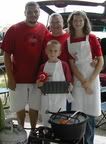How do you plan to garden this year?
Will you plant in single rows, wide rows, till, no till, or maybe lasagna gardening?
No matter the method a little planning can save you time and money.
Here are three steps I used to help me garden.
Simple line drawing of my garden.
A planting table.
Try to keep track of how will the plants in my garden produce,
Step 1. The simple line drawing;
My simple line drawing is just that, simple. I usually just use a paper and pencil and draw out my garden dimensions but In the last couple of years, I have started drawing it out on my computer.
I start by drawing the outline of my permanent raised beds . Then I move on to where I garden strait in the ground. After I have all the garden dimensions mapped out, then I start labeling where I will be planting each item, keeping in mind how much space, sun and water each type of plant will need. (ex. You don’t want to plant sun flowers where they will shade out your green beans)
As I am designing my planting areas I try to keep in mind companion planting. It turns out tomatoes do love carrots so I plan to plant a few carrots around my tomatoes. I remember that onions and beans are not a good match, so I keep them away from each other in my planning. You can get a companion planting chart online at
www.companionplanting.net to help make your own companion planting decisions.
I also consider planting nasturtiums as a trap plant around my cucumbers. The nasturtiums will hopefully attract cucumber beetles away from my cucumbers. Blue Hubbard squash is also a good trap plant to plant on the outside edge of your garden to attract the cucumber beetle away from your squash plants. Basically, I can plant the Blue Hubbard as a decoy away from my cucumbers or squash. Trap planting is a widely use technique in organic gardening.
I also consider a plan for succession planting . Will I plant early peas and lettuce followed by a crop of beans? Will I plant a fall garden? If so what will I plant and when? I decide to plant broccoli, cabbage, cauliflower , carrots and lettuce in the Fall so I can use the same space twice by planting onions, cucumbers and early lettuce in the Spring. This will allow me to get two full plantings in one growing season.
Step 2.
The planting table;
A planting table is just a simple chart that contains information like:
The name of the plant.
The depth each type of seed should be planted.
What temperature the soil should be when planting each type of seed.
Planting times how days before or after first/last frost date
Weeks needed to grow to transplant size (indoors)
Maturity date of plants
Seed spacing for optimal growth
The phases of the moon
Germination length of seeds.(some seeds will come up in 4 to 5 days and other will take as long as 21 days)
What time to plant (planting beans 2 weeks apart )
The planting table can help you stay on track and know that the potatoes need to be in the ground on the full moon by march 17.
That corn should be planted in the ground, when the leafs on the oak trees are the size of squirrels ears.
I do not rely on the information on the back of the seed pack because the information is to generic to be useful. They all pretty much say the exact same thing and this is not helpful information.
This table can help you keep vegetables on your table all summer long or plan for enough vegetables to can or freeze .
Step 3 Keeping track;
From the start to the finish of your garden, you should try to keep track of how well each plant variety produces (if one out produces an other, if one variety is more hardy than the others, or disease resistant problems etc.). You can do this simply by writing down your observations on a note pad, or by using a spread sheet on your PC. I like to note things like: If there was a hot dry spell and the flat beans keep on making but the poll beans just stop. Or If the spring was a wet one and you had bad germination is one type of seed and not the rest that were planted. You can keep track of the weather, the highs and lows, as well as how much rain you have received. These details will also help you to remember where things were planted, so that you can rotate your vegetables to help improve you soil, or disease issues in the next season. You can make this as simple or as detailed as you would like. By doing this, you can review it all season long and see what areas were problematic just by keeping track on the simple stuff. You will also have these notes for your next season to review what worked in your garden and what didn’t. All this is so you will have a better garden each and every year.



